Construction Adhesives Market Size & Insights:
The global construction adhesives market size was valued at $9.6 billion in 2021, and is projected to reach $16.9 billion by 2031, growing at a CAGR of 5.9% from 2022 to 2031. The growth in construction and infrastructure projects, coupled with the high demand for high-performance adhesives in flooring and wall applications, is significantly driving the construction adhesives market. As urbanization continues and infrastructure development expands, the need for reliable, durable, and efficient adhesives in various construction segments, such as flooring, wall panels, and ceiling installations, increases. As a there is boost the demand for construction adhesives market.
Introduction
Construction adhesives are specialized bonding agents used in various construction applications to securely bond materials together, offering superior strength and durability. These adhesives are formulated to provide reliable adhesion to a wide range of substrates, including wood, metal, concrete, glass, ceramics, and plastics. As compare to traditional mechanical fasteners such as nails or screws, construction adhesives offer the benefit of providing a seamless, aesthetic finish and distributing stress evenly across the bonded surface, which helps enhance the structural integrity of construction assemblies.
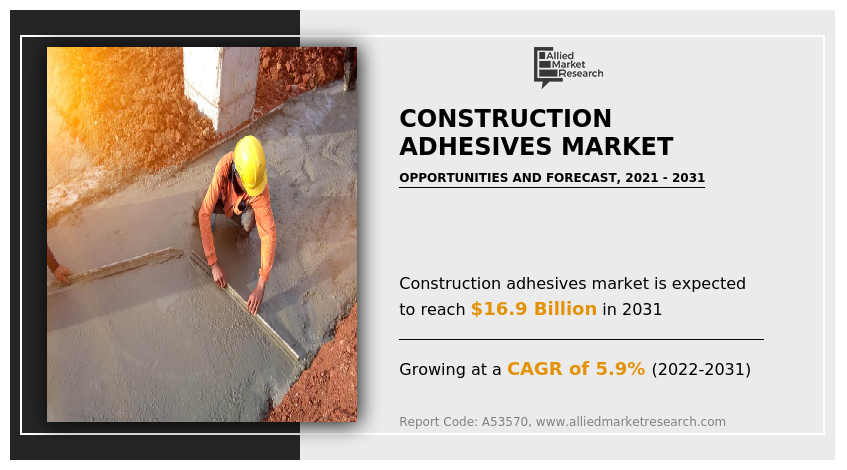
Report key highlighters
- The global construction adhesives market has been analysed in terms of value and volume. The analysis in the report is provided on the basis of resin type, technology, application, 4 major regions, and more than 15 countries.
- The global construction adhesives market report includes a detailed study covering underlying factors influencing the industry opportunities and trends.
- The construction adhesives market is fragmented in nature with various players such as 3M, ARDEX AMERICAS, BASF SE, DAP Global Inc., H.B. Fuller Company, Henkel AG & Co. KGaA, Huntsman International LLC, MAPEI S.p.A., Permabond LLC., and Sika AG. which hold significant share of the market.
- The report facilitates strategy planning and industry dynamics to enhance decision making for existing market players and new entrants entering the construction adhesives industry.
Market Dynamics:
Construction adhesives are specially formulated adhesives that are used to bond and join different types of construction materials, such as wood, metal, plastic, concrete, and others. These adhesives are designed to provide high-strength bonding and improve the durability and stability of structures in residential, commercial, and industrial construction. They are typically used in a wide variety, such as installing flooring, attaching baseboards and crown molding, bonding drywall, and many others. Construction adhesives can be either solvent-based or water-based and are available in a range of formulations to suit different materials and applications. They are an essential component in construction projects and are used to create structures that are stronger, more resilient, and more efficient.
Construction adhesives are used to bond a variety of materials, including wood, metal, concrete, plastic, and others. Construction adhesives are used in various construction applications, including road construction, bridge repair and construction, and tunnel installation. Common uses of construction adhesives in residential housing include installing flooring, attaching baseboards and crown molding, bonding drywall, and other applications that require increased strength and stability.
In commercial buildings, construction adhesives are utilized to improve energy efficiency by creating a tighter seal between components such as windows, doors, and insulation. In infrastructure projects, construction adhesives can help reduce the need for mechanical fasteners such as bolts and screws, creating stronger, more resilient, and more efficient structures which can be applied using various methods such as caulking guns, rollers, and sprayers.
Construction adhesives are highly in demand in building and construction, where they provide a strong, durable, and long-lasting bond between two or more materials. They are commonly used to install different types of flooring, such as wood, vinyl, carpet, and tile. Adhesives provide a strong and stable bond that helps prevent the flooring from shifting or lifting over time.
Construction adhesives are also used to install roofing materials such as shingles, tiles, and membranes which are often designed to withstand extreme weather conditions and to provide a long-lasting seal that helps prevent leaks and water damage. They are also used in wall panelling and drywall providing a strong and reliable bond that helps to hold the panels in place.
Construction adhesives install insulation materials, such as foam boards, to walls, ceilings, and other surfaces. The adhesive provides a strong and secure bond that helps keep the insulation in place. Polyurethane construction adhesives are ideal for use with foam insulation boards as they provide a strong and reliable bond that helps hold the insulation in place. They also have excellent resistance to water and other environmental factors, making them ideal for use in damp or humid environments.
Construction adhesives are used in the construction of concrete and masonry structures, providing a strong and durable bond between the different components of the structure. Construction adhesives are also used to anchor bolts, rebar, and other components in concrete and masonry structures. They provide a strong bond that helps to hold the component in place, even under heavy loads and other stresses.
Growing demand for construction adhesives in residential housing and infrastructure drives the growth of the construction adhesives market.
Construction adhesives are used in the development of infrastructure, such as bridge repair and construction, road construction, and tunnel installation. They are also used in a variety of applications to bond various materials such as concrete, wood, metal, plastic, and others. They are used in the residential housing sector to install flooring, baseboards, crown molding, and drywall.
With a greater emphasis on sustainability and environmental impact, there is a growing demand for environmentally friendly adhesives that do not contain harmful chemicals. Somany introduced the VC shield technology in 2022, which is well-known in the construction industry for its abrasion resistance and long lifespan. China's One Belt, One Road initiative is expected to boost demand for construction adhesive products.
However, stringent regulations associated with the presence of volatile organic compound (VOC) insolvent-based construction adhesives are predicted to hinder the market growth of the construction adhesives market. Governments all over the world have enacted legislation to limit the number of VOCs and to require producers to achieve specified criteria. Low-VOC adhesives may not perform as well as their high-VOC counterparts, making them more difficult to work with or less effective in some situations, but they can help builders meet sustainability goals and enhance the overall quality and efficiency of construction projects.
Manufacturers are investing in the development of low-VOC and VOC-free adhesives, and builders are discovering new and imaginative methods to incorporate adhesives materials into their projects. Volatile organic compounds (VOCs) in solvent-based construction adhesives are becoming more common due to their potential impact on the environment and human health. VOCs are harmful chemicals that can be released into the air during the application and curing of adhesives, contributing to air pollution and potential health risks for workers and building occupants.
Segment Overview:
The construction adhesives market is segmented into resin type, technology, application, and region. On the basis of resin type, the market is categorized into acrylic, polyvinyl acetate, polyurethanes, epoxy, and others. On the basis of technology, the market is categorized into water-based, reactive, solvent-based, and others. On the basis of application, it is categorized into residential, commercial, and industrial. Region-wise the market is studied across North America, Europe, Asia-Pacific, and LAMEA.
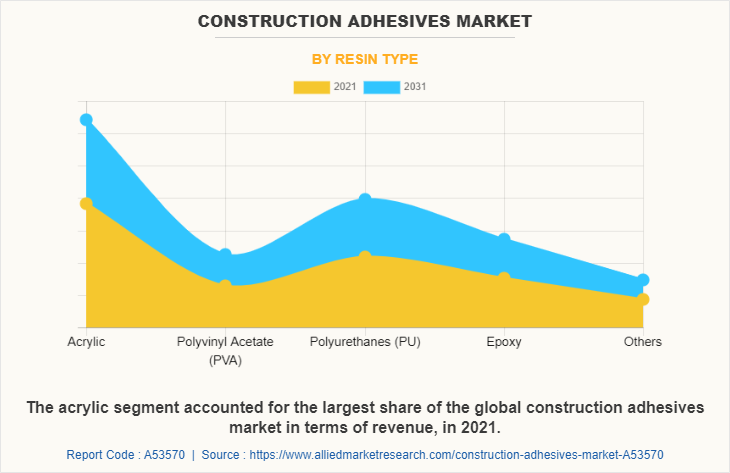
Construction Adhesives Market By Resin Type
The acrylic segment accounted for the largest share of the global construction adhesives market in terms of revenue, in 2021. the acrylic segment dominated the global construction adhesives market in 2021. Acrylic adhesives are versatile and widely used in a range of industrial and commercial applications due to their strong bonding properties, fast curing time, and ability to bond to a variety of surfaces. Acrylic adhesives are also used to bond roofing materials, such as membranes and shingles, to the roof deck. They are also used in the construction of metal roofs and panels.
Acrylic adhesives can provide several advantages over traditional mechanical fasteners, including reduced weight, improved aesthetics, and improved resistance to weather and UV light. They also offer a fast and easy application process and a strong, durable bond. However, it is important to select the appropriate adhesive for the specific application and material to be bonded, and to ensure proper surface preparation to ensure a strong bond.
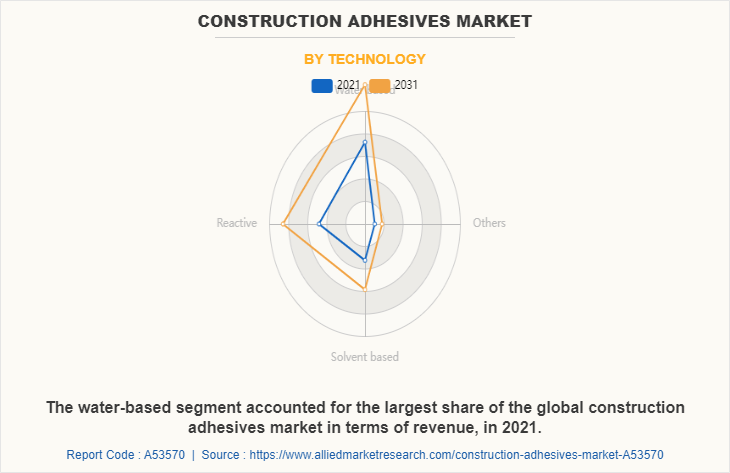
Construction Adhesives Market By Technology
The water-based segment accounted for the largest share of the global construction adhesives market in terms of revenue, in 2021. Water-based construction adhesives are widely used in the construction industry due to their low odor, low VOC (volatile organic compound) content, and ease of use. They are often used in indoor applications where solvent-based adhesives may be unsuitable due to their strong odor and potential health risks.
Water-based construction adhesives are used to bond wood products, such as paneling, trim, and molding. Water-based construction adhesives offer several benefits over traditional solvent-based adhesives, including low odor and low VOC emissions, easy clean-up, and reduced health risks for users. However, they may require longer curing times than solvent-based adhesives and may not be suitable for all applications.
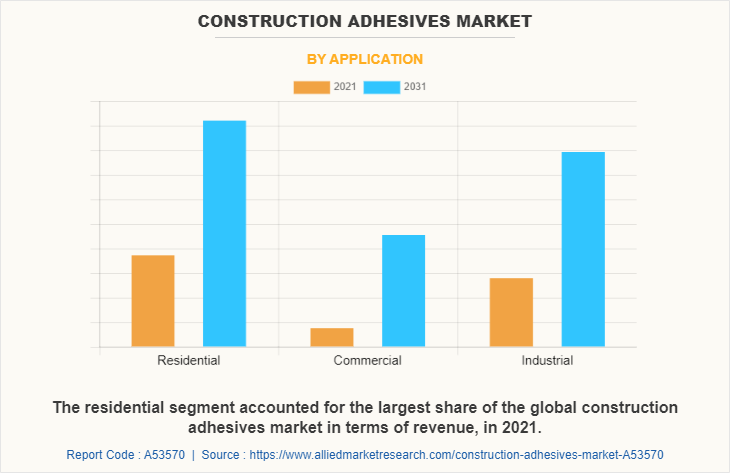
Construction Adhesives Market By Application
The residential segment accounted for the largest share of the global construction adhesives market in terms of revenue, in 2021. Residential construction adhesives are utilized in houses, flats, condos, and interiors to provide greater bonding capabilities. Construction adhesives are utilized in a range of home building applications, including flooring installation, tile installation, wall art, and external insulating material. Building and construction adhesives are also utilized to provide structurally sound and environmentally regulated rooms to house and protect humans and contents. In the residential sector, adhesives are employed as the bonding layer for floor fixing between the existing floor and the substrate.
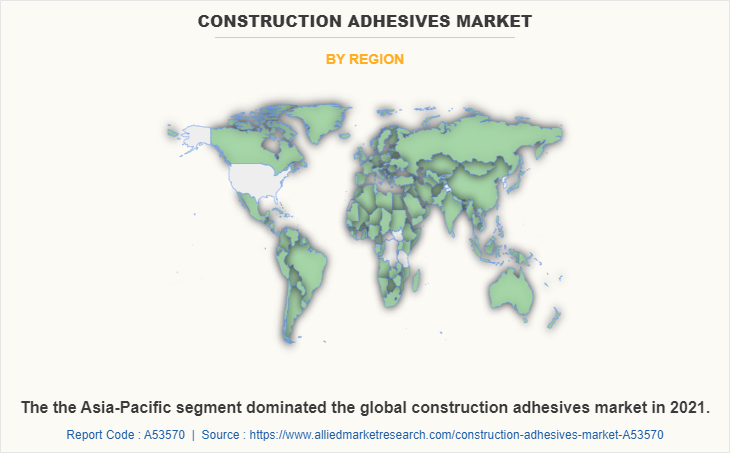
Construction Adhesives Market By Region
The the Asia-Pacific segment dominated the global construction adhesives market in 2021. Acrylic water-borne adhesives and latex water-borne adhesives are widely used in the building and construction industries in Asia-Pacific. Acrylic water-borne adhesives are mostly utilized in the construction industry as pressure-sensitive adhesives in the form of labels and tapes for tile bonding and laminating.
Construction adhesives are used to permanently join surfaces through an adhesive process in Asia-Pacific, whereas increasing government spending on infrastructure and growing demand for low-VOC, green, and sustainable adhesives lamination of sheets drive market growth in the construction adhesives market.
Competitive Analysis:
Major players operating in the global construction adhesives market include 3M, ARDEX AMERICAS, BASF SE, DAP Global Inc., H.B. Fuller Company, Henkel AG & Co. KGaA, Huntsman International LLC, MAPEI S.p.A., Permabond LLC., and Sika AG. These players are adopting several growth strategies to strengthen their position in the market.
Key Benefits For Stakeholders
- This report provides a quantitative analysis of the market segments, current trends, estimations, and dynamics of the construction adhesives market analysis from 2021 to 2031 to identify the prevailing construction adhesives market opportunities.
- The market research is offered along with information related to key drivers, restraints, and opportunities.
- Porter's five forces analysis highlights the potency of buyers and suppliers to enable stakeholders make profit-oriented business decisions and strengthen their supplier-buyer network.
- In-depth analysis of the construction adhesives market segmentation assists to determine the prevailing market opportunities.
- Major countries in each region are mapped according to their revenue contribution to the global market.
- Market player positioning facilitates benchmarking and provides a clear understanding of the present position of the market players.
- The report includes the analysis of the regional as well as global construction adhesives market trends, key players, market segments, application areas, and market growth strategies.
Construction Adhesives Market Report Highlights
| Aspects | Details |
| Market Size By 2031 | USD 16.9 billion |
| Growth Rate | CAGR of 5.9% |
| Forecast period | 2021 - 2031 |
| Report Pages | 350 |
| By Application |
|
| By Resin Type |
|
| By Technology |
|
| By Region |
|
| Key Market Players | Henkel AG & Co. KGaA, BASF SE, Huntsman International LLC, ARDEX AMERICAS, DAP Global Inc., Sika AG, 3M, Permabond LLC., H.B. Fuller Company, MAPEI S.p.A. |
Analyst Review
According to the opinions of various CXOs of leading companies, the construction adhesives market is driven by rise in demand from acrylic resin. Acrylic adhesives are resin-based adhesives using methyl acrylic polymers or acrylic as the main ingredients in building and construction. Acrylic adhesives offer a variety of qualities, including effective bonding, resilience to sunlight and humidity, and durability under changing temperatures, among others in construction. Liquid acrylic adhesives are frequently applied to freshly placed concrete in construction.
Growing demand for construction adhesives in residential housing and infrastructure drives the market growth of construction adhesives. Construction adhesives are used in a range of applications to attach diverse materials such as concrete, wood, metal, plastic, and others. They are utilized in the residential housing sector to install flooring, baseboards, crown molding, and drywall. Construction adhesives provide benefits such as reduced flooring squeaks, increased installation strength and stability, and reduced use of nails and screws.
However, stringent regulations associated with the presence of volatile organic compound (VOC) insolvent-based construction adhesives is expected to restrain industry expansion. VOCs are dangerous compounds that can be released into the air during the application and curing of construction adhesives, leading to air pollution and potentially causing health risks to workers and building occupants.
The Asia-Pacific region is projected to register a robust growth during the forecast period. In Asia-Pacific, construction adhesives are used in many applications of pressure-sensitive adhesives classified into solvent-based and water-based adhesives. Construction adhesives are growing in popularity in Asia-Pacific for glues for lettering film, glue for outdoor billboard advertisements on buses or T-bars, labels & stickers glued on polyethylene terephthalate (PET) or polyvinyl chloride (PVC) film, labels & stickers glue for paper and others.
3M, ARDEX AMERICAS, BASF SE, DAP Global Inc., H.B. Fuller Company, Henkel AG & Co. KGaA, Huntsman International LLC, MAPEI S.p.A., Permabond LLC., and Sika AG. are the major players operating in construction adhesives market
Asia-Pacific is the largest regional market for construction adhesives
Water-based segment are the dominated dominated segment by technology in construction adhesives market.
The leading application of construction adhesives market are residential, commercial, and industrial.
The rising government spending on public infrastructure and commercial buildings is driven by factors such as population growth, urbanization, and the need to upgrade aging infrastructure are the upcoming trends of construction adhesives market in the world.
Loading Table Of Content...



